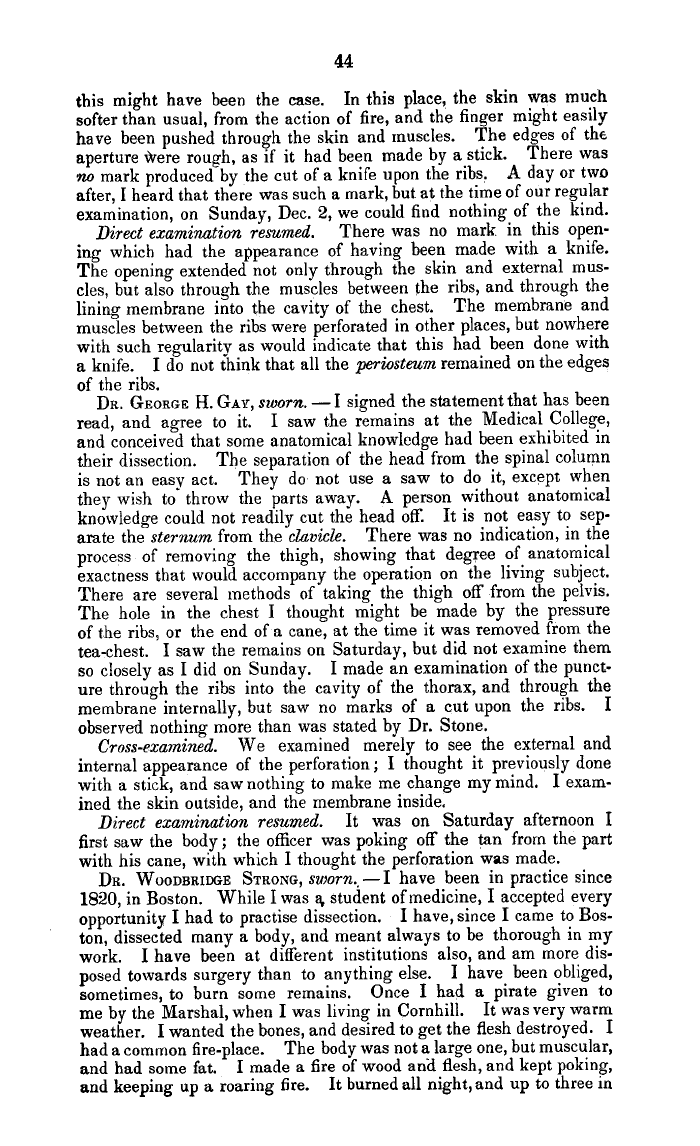|
44
this might have been the case. In this place, the skin was much
softer than usual, from the action of fire, and the finger might easily
have been pushed through the skin and muscles. The edges of the
aperture were rough, as if it had been made by a stick. There was
no mark produced by the cut of a knife upon the ribs. A day or two
after, I heard that there was such a mark, but at the time of our regular
examination, on Sunday, Dec. 2, we could find nothing of the kind.
Direct examination resumed. There was no mark. in this open-
ing which had the appearance of having been made with a knife.
The opening extended not only through the skin and external mus-
cles, but also through the muscles between the ribs, and through the
lining membrane into the cavity of the chest. The membrane and
muscles between the ribs were perforated in other places, but nowhere
with such regularity as would indicate that this had been done with
a knife. I do not Think that all the periosteum remained on the edges
of the ribs.
DR. GEORGE H. GAY, sworn. - I signed the statement that has been
read, and agree to it. I saw the remains at the Medical College,
and conceived that some anatomical knowledge had been exhibited in
their dissection. The separation of the head from the spinal column
is not an easy act. They do not use a saw to do it, except when
they wish to throw the parts away. A person without anatomical
knowledge could not readily cut the head off. It is not easy to sep-
arate the sternum from the clavicle. There was no indication, in the
process of removing the thigh, showing that degree of anatomical
exactness that would accompany the operation on the living subject.
There are several methods of taking the thigh off from the pelvis.
The hole in the chest I thought might be made by the pressure
of the ribs, or the end of a cane, at the time it was removed from the
tea-chest. I saw the remains on Saturday, but did not examine them
so closely as I did on Sunday. I made an examination of the punct-
ure through the ribs into the cavity of the thorax, and through the
membrane internally, but saw no marks of a cut upon the ribs. I
observed nothing more than was stated by Dr. Stone.
Cross-examined. We examined merely to see the external and
internal appearance of the perforation; I thought it previously done
with a stick, and saw nothing to make me change my mind. I exam.
ined the skin outside, and the membrane inside.
Direct examination resumed. It was on Saturday afternoon I
first saw the body; the officer was poking off the tan from the part
with his cane, with which I thought the perforation was made.
DR. WOODBRIDGE STRONG, sworn. -I have been in practice since
1820, in Boston. While I was a, student of medicine, I accepted every
opportunity I had to practise dissection. I have, since I came to Bos-
ton, dissected many a body, and meant always to be thorough in my
work. I have been at different institutions also, and am more dis-
posed towards surgery than to anything else. I have been obliged,
sometimes, to burn some remains. Once I had a pirate given to
me by the Marshal, when I was living in Cornhill. It was very warm
weather. I wanted the bones, and desired to get the flesh destroyed. I
had a common fire-place. The body was not a large one, but muscular,
and had some fat. I made a fire of wood and flesh, and kept poking,
and keeping up a roaring fire. It burned all night, and up to three in
|

